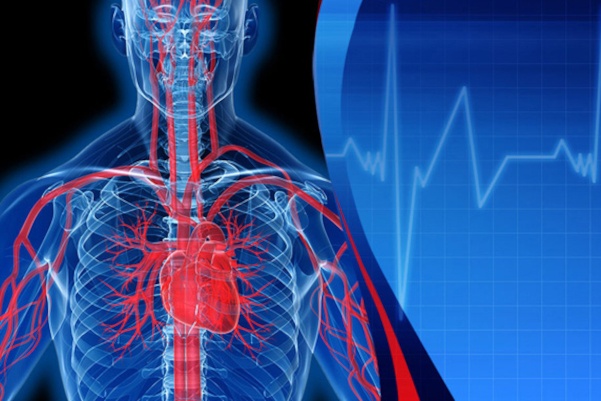
Scimitar syndrome: causes, symptoms, diagnosis, treatment, prognosis and mortality
Scimitar syndrome (congenital pulmonary venolobar syndrome or congenital pulmonary venolobar syndrome or Halasz syndrome) is a congenital cardiopulmonary defect, i.e. already present at birth, in which the right inferior pulmonary vein (called the ‘scimitar vein’) drains into the inferior vena cava instead of into the left atrium as it normally does (left-right shunt)
The result is therefore that oxygenated blood returning from the lungs via the scimitar vein, instead of entering the left side of the heart and being fed back into the systemic circulation via the aorta, ends up in the right side of the heart, which feeds it back into the pulmonary circulation, with an obvious reduction in the efficiency of the cardiopulmonary system.
It is usually associated with hypoplasia of the right lung, bronchial abnormalities and dextrocardia.
It constitutes a type of partial anomalous pulmonary venous return (RVPAP).
Scimitar syndrome owes its curious name to the fact that the anomalous pulmonary vein takes the shape of a scimitar
Scimitar syndrome is also called by the following names, all of which are synonyms:
- pulmonary hypogenesis syndrome;
- Halasz syndrome;
- right pulmonary artery epibronchial syndrome;
- congenital pulmonary venolobar syndrome.
Scimitar syndrome has an estimated prevalence of between 1/100,000 and 1/33,333 live births
Females appear to be more affected than males.
Scimitar syndrome is a congenital condition, i.e. already present at birth.
Symptoms generally begin in the first few months of life.
The exact causes of scimitar syndrome have not yet been fully clarified.
In some patients, an abnormal gene mapped on chromosome 4q12 has been found.
One of the risk factors could be familiarity.
Signs and symptoms
In the neonatal period, scimitar syndrome presents with congestive heart failure, mostly due to pulmonary hypertension and respiratory distress; the newborn presents with fatigability, dyspnoea, heart failure, lack of appetite, irritability and frequent lung infections.
Diagnosis of scimitar syndrome
The diagnosis is suspected on physical examination and confirmed by transesophageal or transthoracic echocardiography, chest X-ray, angiography, computed tomography and magnetic resonance angiography.
On objective examination, a systolic murmur from hyperafflux, a diastolic roll from tricuspid stenosis and a splitting of the II tone are auscultated.
The characteristic sign identifiable on chest X-ray, which also gives the disease its name, is a scimitar-shaped lesion (see image below).
Random diagnosis
In rare cases, scimitar syndrome remains relatively paucisymptomatic in newborns and infants, and in this case it may be diagnosed by chance in older children and adults who undergo a chest X-ray for other reasons. In very rare cases it is never diagnosed in life.
Differential diagnosis
Scimitar syndrome must be differentiated from:
- pseudoscimitar syndrome (abnormal descending vein draining into the left atrium)
- Kartagener syndrome.
Prenatal diagnosis
Prenatal diagnosis is possible with echocardiography of the foetus.
Laboratory examinations
On chest X-ray, enlargement of the right ventricle, dilation of the pulmonary artery, pulmonary overflow, scimitar shadow of the abnormal right pulmonary vein along the right side of the heart can be seen.
Conditions associated with scimitar syndrome
Variable hypoplasia and malformations of the pulmonary arteries of the right lung and an abnormal arterial supply from the aorta, which may originate above or below the diaphragm, have been observed.
The heart is usually displaced to the right. In rare cases, the disease manifests with a small shunt, a heart murmur and recurrent respiratory infections in children and adults.
About a quarter of patients have a related congenital heart disease (aortic coarctation, tetralogy of Fallot, patent ductus arteriosus, ventricular septal defect).
Bronchogenic cysts, ‘horseshoe’ lung, accessory diaphragm and hernias may be associated.
Treatment
Therapy depends on the haemodynamic status: when the amount of blood flowing to the inferior vena cava is minimal, therapy may not be applied, however it is convenient for the patient to undergo periodic check-ups.
In cases of left-right shunt and significant pulmonary hypertension, surgical correction should be proposed, which could include correction of the abnormal venous return, ligation of collateral arteries and right pneumonectomy.
Surgical treatment is performed in extracorporeal circulation (ECC).
When to operate?
Surgical treatment is generally carried out at pre-school age, i.e. before the age of 5/6 years.
Mortality and prognosis
When the amount of blood flowing to the inferior vena cava is minimal, life expectancy is comparable to that of a healthy individual.
The quality of life in these patients is high, however some sports may be precluded, especially competitive ones.
In severe cases and if diagnosed during childhood, the syndrome is associated with significant mortality.
The main causes of death in individuals with scimitar syndrome are:
- respiratory failure;
- heart failure;
- severe pulmonary infections.
Read Also:
Emergency Live Even More…Live: Download The New Free App Of Your Newspaper For IOS And Android
Ectopia Cordis: Types, Classification, Causes, Associated Malformations, Prognosis
Defibrillator: What It Is, How It Works, Price, Voltage, Manual And External
The Patient’s ECG: How To Read An Electrocardiogram In A Simple Way
Signs And Symptoms Of Sudden Cardiac Arrest: How To Tell If Someone Needs CPR
Inflammations Of The Heart: Myocarditis, Infective Endocarditis And Pericarditis
Quickly Finding – And Treating – The Cause Of A Stroke May Prevent More: New Guidelines
Atrial Fibrillation: Symptoms To Watch Out For
Wolff-Parkinson-White Syndrome: What It Is And How To Treat It
Do You Have Episodes Of Sudden Tachycardia? You May Suffer From Wolff-Parkinson-White Syndrome (WPW)
Transient Tachypnoea Of The Newborn: Overview Of Neonatal Wet Lung Syndrome
Tachycardia: Is There A Risk Of Arrhythmia? What Differences Exist Between The Two?
Bacterial Endocarditis: Prophylaxis In Children And Adults
Erectile Dysfunction And Cardiovascular Problems: What Is The Link?
Ischaemic Heart Disease: What It Is, How To Prevent It And How To Treat It
Ischaemic Heart Disease: Chronic, Definition, Symptoms, Consequences


